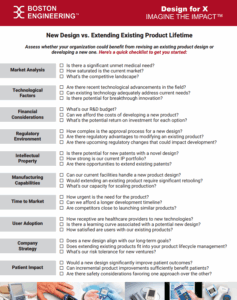Service Desk for PTC Windchill and ThingWorx IIoT
![]()
![]()
Use the Boston Engineering customer portal to submit service requests, get status updates, and Check PLM/IIoT KPIs.
![]()
![]()
Use the Boston Engineering customer portal to submit service requests, get status updates, and Check PLM/IIoT KPIs.

Managed services portal access

PTC + ThingWorx + Vuforia

Ansys
 Boston Engineering’s Medical Product Checklist provides a comprehensive guide to evaluating whether your organization could benefit from revising an existing product design or developing a new one.
Boston Engineering’s Medical Product Checklist provides a comprehensive guide to evaluating whether your organization could benefit from revising an existing product design or developing a new one.
This checklist helps your company to evaluate important considerations including the current market landscape, technological factors, regulatory environment, manufacturing capabilities, patient impact, and more.